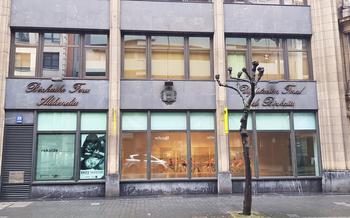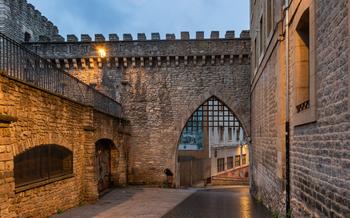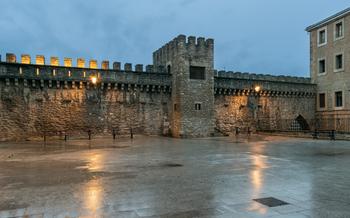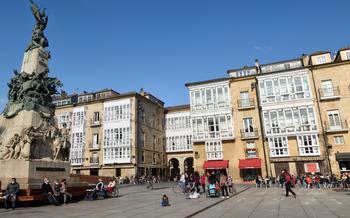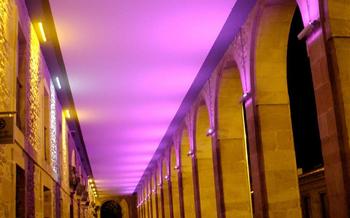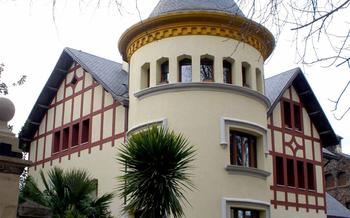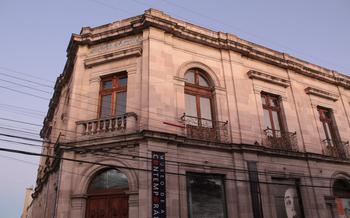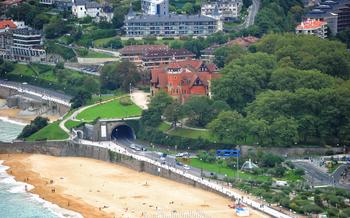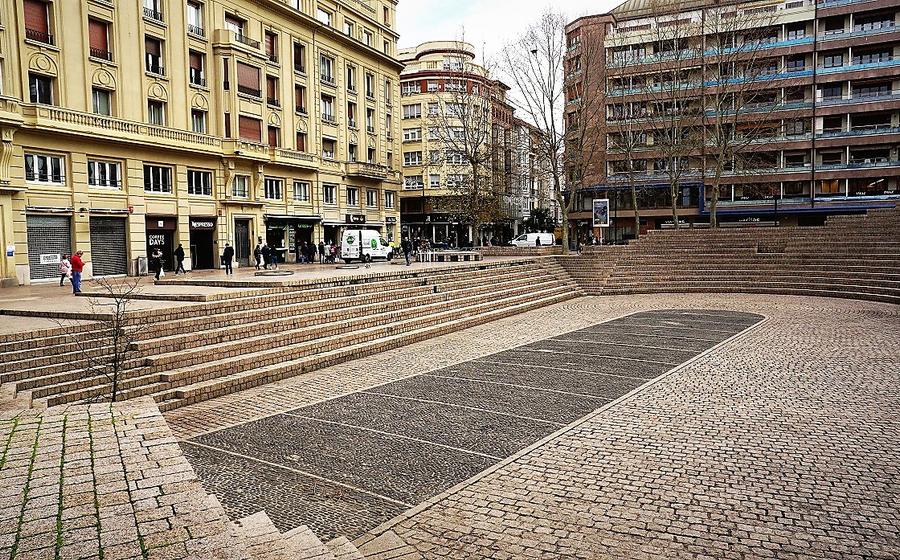
Artium, Basque Centre Museum of Contemporary Art
- Permanent Collection
- Temporary Exhibitions
- Cultural Events and Activities
- Guided Tours
- Research and Publications
- Accessibility
- Location and Transportation
- Community Involvement and Outreach
- Insider Tip:
Permanent Collection
The Artium's permanent collection is a diverse and comprehensive representation of contemporary Basque and Spanish art, showcasing works from the mid-20th century to the present. It features over 3,000 artworks, including paintings, sculptures, installations, and audiovisual pieces.
Notable artists whose works are featured include Eduardo Chillida, Jorge Oteiza, Antoni Tàpies, and Juan Muñoz. Chillida's sculptures, characterized by their monumental scale and organic forms, are a highlight of the collection. Oteiza's abstract sculptures explore themes of Basque identity and culture. Tàpies's mixed media works combine materials such as sand, paint, and collage to create evocative and textured surfaces. Muñoz's installations often play with the boundaries between reality and illusion, inviting viewers to question their perceptions.
The museum's curatorial approach emphasizes the interrelationship between different artistic disciplines and the evolution of contemporary art in Spain. It presents works not only in isolation but also in dialogue with each other, creating a dynamic and engaging experience for visitors.
Educational and interactive elements are incorporated throughout the permanent collection, providing visitors with deeper insights into the artworks and the artists' creative processes. These include touchscreens with information about the pieces, interactive displays that allow visitors to explore different aspects of the works, and hands-on activities for children.
Temporary Exhibitions
Temporary exhibitions at the Artium are a vibrant and dynamic aspect of the museum's programming. Designed to complement and enhance the permanent collection, these exhibitions showcase a diverse range of contemporary art practices, emerging artists, and innovative curatorial approaches.
The nature of temporary exhibitions is fluid and ever-changing, reflecting the latest trends and developments in the art world. They offer a platform for experimentation, pushing boundaries and challenging conventional notions of art and creativity. The museum's commitment to presenting diverse perspectives ensures that visitors are exposed to a wide spectrum of artistic expressions, fostering a deeper understanding and appreciation of contemporary art.
The frequency of temporary exhibitions varies, with several exhibitions running concurrently or in rotation throughout the year. This allows the museum to present a continuous stream of fresh and thought-provoking content, catering to a wide range of interests and preferences.
Curating temporary exhibitions involves a rigorous process of research, selection, and collaboration. The museum's curatorial team works closely with artists, galleries, and other institutions to bring together compelling and cohesive exhibitions. Each exhibition is carefully planned and designed to create a unique and immersive experience for visitors.
Past notable temporary exhibitions at the Artium have included retrospectives of renowned artists, thematic group shows exploring specific concepts or movements, and site-specific installations that engage with the museum's architecture and surroundings. These exhibitions have garnered critical acclaim and attracted a diverse audience, solidifying the Artium's reputation as a leading center for contemporary art.
Cultural Events and Activities
The Artium is not just a place to admire art but also a vibrant hub for cultural events and activities that engage the community and promote artistic expression. Throughout the year, the museum hosts a diverse array of events designed to cater to various interests and age groups.
Exhibitions: In addition to the permanent and temporary exhibitions, the Artium frequently organizes smaller-scale exhibitions highlighting specific artists, themes, or artistic movements. These exhibitions provide a platform for emerging and established artists to showcase their work and offer visitors an opportunity to discover new perspectives and artistic styles.
Lectures and Talks: The museum regularly invites renowned artists, curators, and scholars to deliver lectures, talks, and workshops on a wide range of art-related topics. These events provide an avenue for visitors to learn about the creative process, gain insights into the history and theory of art, and engage in thought-provoking discussions.
Film Screenings: The Artium hosts film screenings that explore the intersection of cinema and contemporary art. These screenings showcase experimental films, documentaries, and short films that challenge conventional narratives and offer unique perspectives on art and society.
Performances and Installations: The museum collaborates with local artists and performers to create immersive and site-specific installations and performances within the museum space. These events often blur the boundaries between art, theater, and dance, offering visitors a multisensory and interactive experience.
Family Days and Workshops: The Artium recognizes the importance of fostering creativity and appreciation for art from a young age. Family days and workshops are organized during weekends and school holidays, providing children and their families with an opportunity to engage in hands-on art activities, storytelling sessions, and guided tours designed specifically for younger audiences.
Guided Tours
The Artium offers guided tours in multiple languages to enhance visitors' understanding and appreciation of the museum's collection and temporary exhibitions. Visitors can choose from a range of tour options, including general overviews, in-depth analyses of specific themes or artists, and specialized tours for families and school groups. The tours are led by knowledgeable and passionate art historians and educators who provide insightful commentary and answer questions as you explore the museum.
Booking a guided tour is highly recommended as it gives you the opportunity to gain a deeper understanding of the artworks and their significance within the context of contemporary art history. Tours are available upon reservation, and fees vary depending on the type of tour and group size. For the best experience, book your tour in advance to secure your spot.
Research and Publications
The Artium is not just a place to appreciate art; it is also a hub for art research and scholarship. The museum houses a dedicated research center that encourages and supports academic inquiry into contemporary art. Researchers, scholars, and students from around the world come to the Artium to access its extensive collection of books, journals, and other research materials.
The Artium also publishes its own research papers and exhibition catalogs, which provide in-depth analysis of the museum's collection and exhibitions. These publications are widely respected in the art world and contribute to the broader understanding of contemporary art.
In addition, the Artium collaborates with universities and other institutions to conduct joint research projects and organize conferences and symposiums. Through these collaborations, the museum fosters a vibrant intellectual community and promotes the exchange of ideas and knowledge.
The Artium's commitment to research and scholarship helps to position it as a leading center for contemporary art. Its research activities not only contribute to the museum's own exhibitions and programs but also have a broader impact on the art world, advancing the understanding and appreciation of contemporary art.
Accessibility
The Artium is committed to providing an inclusive and welcoming environment for all visitors, regardless of their abilities. The museum has made significant efforts to ensure that its facilities and services are accessible to everyone.
Wheelchair users and visitors with limited mobility can easily navigate the museum's spacious galleries and public areas. Ramps and elevators provide access to all levels of the building, making it easy for everyone to explore the exhibits.
The museum also offers a variety of assistive devices, such as wheelchairs, magnifying glasses, and audio guides, to enhance the experience of visitors with disabilities. Guided tours and materials are available in multiple languages, including sign language, to accommodate visitors from diverse backgrounds.
The Artium's commitment to accessibility extends beyond its physical space. The museum's website is designed to be accessible to users with visual impairments, and online exhibits and virtual tours are available for those who are unable to visit the museum in person.
Through its dedication to accessibility, the Artium ensures that everyone has the opportunity to experience and appreciate the wonders of contemporary art. The museum's efforts have been recognized and commended by organizations such as the Spanish Association of Accessibility and the European Disability Forum.
Location and Transportation
The Artium is situated in the heart of Vitoria-Gasteiz, in a visually striking building designed by Basque architects Jose Luis Caton and Fernando Tabuenca. Its specific address is Calle Francia, 24, 01002 Vitoria-Gasteiz, Álava, Spain.
Reaching the museum by public transportation is convenient and accessible. Visitors can utilize the efficient bus network, with multiple bus lines stopping within walking distance of the Artium. Bus lines 1, 3, 5, 6, 7, 9, 10, and 13 all have stops nearby, making it effortless to connect from various points of the city.
For those who prefer the flexibility of driving, the Artium offers ample parking options. The museum's parking garage, located underground, provides secure and convenient parking spaces, ensuring a hassle-free visit.
Moreover, the Artium's prime location makes it an ideal destination for pedestrians and cyclists. Vitoria-Gasteiz is renowned for its walkability, and the Artium is situated within a pleasant and safe pedestrianized area. Cyclists can take advantage of the well-established bike lanes throughout the city, making the museum easily accessible by bicycle.
Community Involvement and Outreach
The Artium takes pride in its role as a cultural hub and actively engages with the local community through various initiatives and collaborations. The museum works closely with schools, universities, and cultural organizations to develop educational programs and workshops tailored to different age groups and interests. These programs aim to foster creativity, critical thinking, and an appreciation for contemporary art among the younger generation.
Beyond traditional educational outreach, the Artium extends its impact through innovative community projects. The museum collaborates with local artists, community groups, and NGOs to create participatory art projects, exhibitions, and events that address social issues, promote dialogue, and celebrate diversity. These initiatives not only enrich the museum's programming but also contribute to the cultural fabric of Vitoria-Gasteiz.
The Artium's commitment to community engagement extends to its digital presence. Through social media platforms, the museum shares behind-the-scenes glimpses, artist interviews, and educational content, reaching a broader audience and fostering a sense of connection with art enthusiasts worldwide. The museum's website also features virtual tours, online exhibitions, and educational resources, making art accessible to those who may not be able to visit the museum physically.
By actively engaging with the community, the Artium not only fulfills its mission of promoting contemporary art but also contributes to the cultural vitality and social fabric of Vitoria-Gasteiz, fostering a sense of inclusivity and belonging for all.
Insider Tip:
To fully immerse yourself in the tranquil ambiance of the Artium, plan your visit for a weekday morning. This strategic timing allows you to avoid the weekend crowds and savor the serene atmosphere, granting you ample space to contemplate and appreciate the artworks without distractions.
As you wander through the galleries, keep an eye out for hidden gems that may not immediately catch your attention. Seek out lesser-known pieces by emerging or local artists, and take the time to uncover their unique perspectives and artistic expressions. These hidden treasures often reveal captivating stories and offer a deeper insight into the diverse range of talents showcased at the Artium.
Before or after your visit, venture into the surrounding neighborhood to discover a culinary gem. Several charming cafes and restaurants are nestled in the vicinity, offering delectable local cuisine and a vibrant atmosphere. Indulge in traditional Basque dishes or savor innovative culinary creations while immersing yourself in the city's vibrant culinary scene.
Don't forget to capture your Artium experience through the lens of your camera. The museum's striking architecture and captivating exhibits provide ample opportunities for stunning photographs. Experiment with different angles and perspectives to create unique shots that capture the essence of the Artium's artistic treasures.
